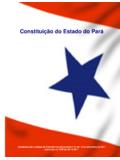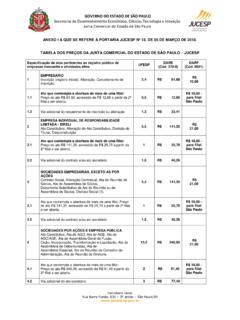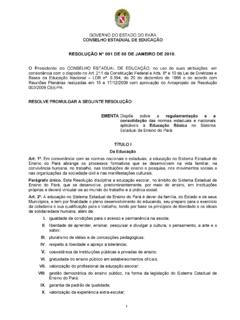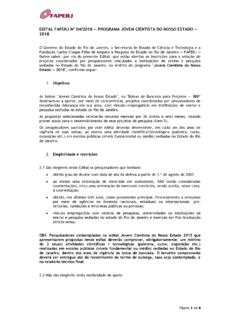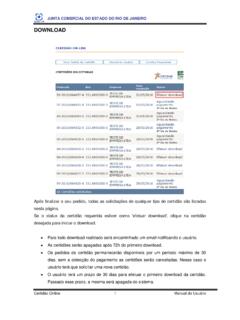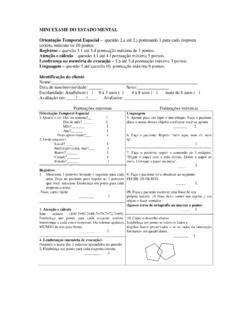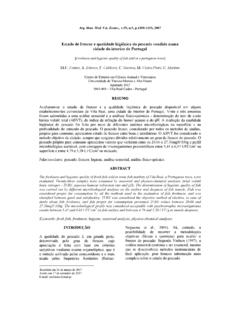Transcription of The State of the World’s Forest Genetic Resources …
1 I3825E/1 978-92-5-108402-1978 9251 084021iTHE State OF THE world sFOREST Genetic RESOURCESCOMMISSION ON Genetic Resources FOR FOOD AND AGRICULTURE FOOD AND AGRICULTURE ORGANIZATION OF THE UNITED NATIONSRome, 2014 The designations employed and the presentation of material in this information product do not imply the expression of any opinion whatsoever on the part of the Food and Agriculture Organization of the United Nations (FAO) concerning the legal or development status of any country, territory, city or area or of its authorities, or concerning the delimitation of its frontiers or boundaries. The mention of specific companies or products of manufacturers, whether or not these have been patented, does not imply that these have been endorsed or recommended by FAO in preference to others of a similar nature that are not 978-92-5-108402-1 (print)E-ISBN 978-92-5-108403-8 (PDF) FAO, 2014 FAO encourages the use, reproduction and dissemination of material in this information product.
2 Except where otherwise indicated, material may be copied, downloaded and printed for private study, research and teaching purposes, or for use in non-commercial products or services, provided that appropriate acknowledgement of FAO as the source and copyright holder is given and that FAO s endorsement of users views, products or services is not implied in any requests for translation and adaptation rights, and for resale and other commercial use rights should be made via or addressed to information products are available on the FAO website ( ) and can be purchased through cover nearly one-third of the world s land area. They provide vital environmental services such as soil and water protection, regulate the climate and preserve biodiversity, produce valuable raw materials and food, and sustain the livelihoods of millions of Genetic Resources the heritable materials maintained within and among trees and other woody plant species are essential for the adaptation and the evolutionary processes of forests and trees as well as for improving their resilience and productivity.
3 The conservation of Forest Genetic Resources is more topical than ever at a time when the world is increasingly confronted with challenges from increased human population, land-use changes and climate change. These pressures, and related increases in unsustainable use, wildfire, pests and diseases, as documented in the Climate change 2013 report of the Intergovernmental Panel on Climate Change (IPCC), are causing losses of Forest cover and of Forest biodiversity, both among and within species. Lack of information limits the capacity of many countries and the international community to develop appropriate policy tools to address the issues or to integrate Forest Genetic Resources management into relevant cross-cutting sectorial policies. Reliable data on the status and trends of Forest Genetic Resources are required for decision-makers and stakeholders to provide adequate support for their sustainable management.
4 Recognizing this need for information and the urgency of addressing the conservation and sustainable use of Forest Genetic Resources , the Commission on Genetic Resources for Food and Agriculture requested and guided the preparation of The State of the world s Forest Genetic Resources , and agreed, in response to its findings, on strategic priorities which the FAO Conference adopted in June 2013 as the Global Plan of Action for the Conservation, Sustainable Use and Development of Forest Genetic first ever report on The State of the world s Forest Genetic Resources constitutes a milestone in building the information and knowledge base required for action at the national, regional and international levels. It has been developed through a country-driven process, building on 86 country reports representing over 85 percent of global Forest cover and with the participation of representatives from national institutions and non-governmental and community-based organizations.
5 Its recommendations are based on these reports, which indicate that about half of the Forest species in reporting countries are threatened or subject to Genetic erosion, and only about one-quarter are actively managed for their products and/or services. This publication provides the basis for renewed efforts to realize national and international commitments to improved conservation, sustainable use and management of Forest Genetic established in its Reviewed Strategic Framework 2010-2019 and in particular through its Strategic Objective 2, FAO is striving to increase and improve provision of goods and services from agriculture, forestry and fisheries in a sustainable manner . Measures include strengthening its technical support to countries in the area of Forest Genetic Resources and promoting the integration of Forest Genetic Resources into broader Forest resource management programmes at the national, regional and international levels.
6 This report is a key ingredient in this am confident that the information in The State of the world s Forest Genetic Resources will be used as the basis for policy and technical decisions to strengthen national efforts in ivconservation and sustainable management of Forest Genetic Resources , efforts that will contribute to meeting the world s current and future needs for Forest products and environmental services while enhancing food iiiAcknowledgements xiiiAbout this publication xvExecutive summary xxiPart 1 OverviewCHAPTER 1 BASIC CONCEPTS 3 Definitions 4 Characteristics of Forest Genetic Resources 8 Species diversity 11 CHAPTER 2 VALUE AND IMPORTANCE OF Forest Genetic Resources 19 Economic value 20 Environmental value, ecosystem services and resilience 22 Social, cultural.
7 Medicinal and scientific value 24 Preserving options for future development and adaptation 25 CHAPTER 3 CONSERVATION OF Forest Genetic Resources 27 Management systems in the field (in situ and circa situm conservation) 28Ex situ conservation 32 Targeted species-based approach 39 CHAPTER 4 KNOWLEDGE AND INFORMATION ON Forest Genetic Resources 41 What constitutes knowledge of Forest Genetic Resources ? 42 Availability of information on Genetic Resources 46 Part 2 Drivers of change and trends affecting Forest Genetic resourcesCHAPTER 5 DRIVERS OF CHANGE 51 Forest conversion and expansion of crop land 51 Demand for energy 52 Unsustainable harvesting and use 53 Livestock and browse animals 54 Climate change 54 Changed fire regimes 58 Invasive species 59 Genetic pollution 62 CHAPTER 6 GLOBAL Forest TRENDS AFFECTING Forest Genetic DIVERSITY 65 Forest trends 65 Consequences of Forest changes for Genetic diversity 70viPart 3 Current and emerging technologiesCHAPTER 7 TRAIT-BASED KNOWLEDGE OF TREE Genetic Resources 79 Indigenous and traditional knowledge 79 Classical tree improvement 83 Participatory tree domestication 89 CHAPTER 8 MODERN ADVANCES 91 Population genetics based on molecular markers 91 Genomic
8 Advances 94 Combining molecular tools with tree improvement: marker-assisted selection 96 Genetic modification 98 CHAPTER 9 APPLICATION OF Genetic KNOWLEDGE IN Forest CONSERVATION 101 Combining spatial analysis with Genetic markers to prioritize conservation 102 Research on climate change and Forest Genetic Resources 103 Genetic technologies for reducing illegal logging 104 Part 4 State of Forest Genetic Resources conservation and managementCHAPTER 10 HOW COUNTRIES MANAGE AND CONSERVE THEIR Forest Genetic Resources 111 Features of effective and comprehensive FGR conservation and management systems 112 Approaches to FGR conservation in relation to biodiversity conservation strategies 114 National strategies and programmes for FGR conservation and management 116 Prioritizing species for FGR conservation and management
9 116 CHAPTER 11 CHARACTERIZATION OF Genetic VARIABILITY AND MONITORING OF CHANGE 121 Characterizing interspecific variability 123 Characterizing intraspecific variation 124 Monitoring of Forest Genetic Resources 131 Differences among countries and regions in characterization of FGR 133viiCHAPTER 12 IN SITU FGR CONSERVATION AND MANAGEMENT 135 Protected areas 138 In situ conservation outside protected areas 140 Formal in situ FGR conservation programmes 142 Forest restoration and FGR 150 Opportunities from climate change initiatives: restoration and connectivity for in situ FGR 151 In situ conservation through sustainable Forest management 152 CHAPTER 13 EX SITU CONSERVATION 163 Ex situ conservation activities by region 164 CHAPTER 14 Genetic IMPROVEMENT AND BREEDING PROGRAMMES 173 Improvement approaches 174 Administration and coordination of breeding and improvement programmes 175 Prioritizing uses, traits and species for improvement 177 The State of tree improvement and species priorities by region 179 International collaboration and donor programmes for tree improvement 187 A cautionary note.
10 Potential threats to FGR from breeding and improvement programmes 187 CHAPTER 15 GERMPLASM DELIVERY AND DEPLOYMENT 189 Uses of germplasm and plant materials 189 Demand for germplasm and planting materials 190 Actors involved in production, distribution and deployment 191 Production of germplasm and planting materials 195 Movement and transfer of Genetic material 199 Information management in delivery and deployment of germplasm 204 International assistance 205 CHAPTER 16 INSTITUTIONAL FRAMEWORK FOR CONSERVATION AND MANAGEMENT OF Forest Genetic Resources 207 National institutions dealing with Forest Genetic Resources 207 Legal and policy framework 208 Education and training 208 Research 208 Raising public awareness and communication 208 Support to Forest Genetic Resources 209 International and regional collaboration 209viiiPart 5 Needs.











